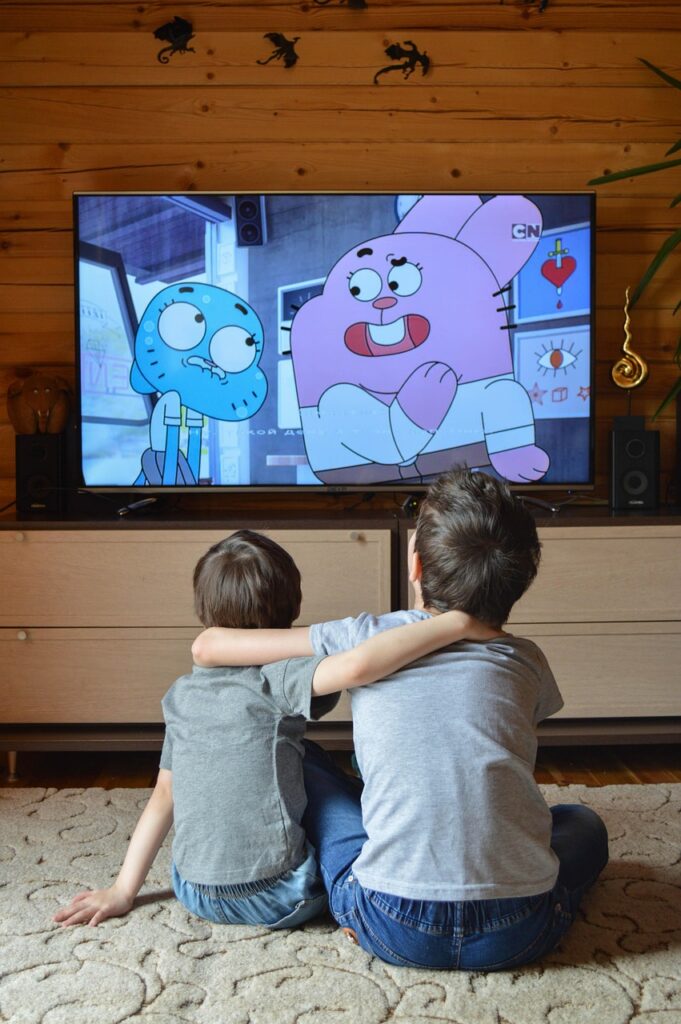
In an era where the television landscape feels constantly in flux, the very notion of how we discover and critically engage with films has undergone a seismic shift. Gone are the days when a handful of network TV critics held singular sway over public opinion, their pronouncements often the first or only word viewers heard before deciding what to watch. Today, the discerning cinephile, particularly within the vast and varied realm of horror, navigates a sprawling digital ecosystem that offers an embarrassment of riches—and, crucially, entirely new forms of ‘review’ and curation.
This evolving media terrain demands a fresh perspective on how we evaluate content. Network television, with its broad appeal and often sanitized offerings, can no longer capture the nuanced, niche, or truly terrifying corners of cinematic art. Instead, a new breed of gatekeepers has emerged: dedicated streaming services. These platforms, through their meticulously assembled catalogs, exclusive original programming, and specialized filters, don’t just *host* movies; they actively *curate* them, implicitly ‘reviewing’ them by deeming them worthy of inclusion in their distinctive collections. This shift means that the true critics of our time are often algorithms and editorial teams, shaping our tastes and unearthing gems that traditional broadcast would never touch.
For horror aficionados especially, this revolution is nothing short of transformative. These services have become indispensable guides, each offering a distinct lens through which to explore the genre’s multifaceted horrors. They cater to every conceivable craving, from the gore-hounds to the psychological thrill-seekers, the purveyors of schlock to the students of cinematic artistry. We embark on a journey through ten such essential platforms, beginning with five that have profoundly reshaped the dialogue around horror, proving that the most influential voices are no longer just heard, but *streamed*.
1. **Shudder: The Undisputed Home of High-Quality Niche Horror**When you’re truly seeking a scare that digs its claws in deep, Shudder is, unequivocally, an excellent option. This isn’t just another streaming service; it’s a meticulously curated sanctuary for horror film lovers, a fact underscored by its origin as an AMC Networks operation launched in 2016. Shudder prides itself on a diverse array of horror films, spanning the spectrum from the bloodiest slashers to mind-bending psychological thrillers, offering a breadth rarely matched elsewhere.
Its library is studded with treasures like “Carrie,” “Grave,” “The House of the Devil,” “Jug Face,” and “They Look Like People,” each a testament to its commitment to quality within the genre. What truly sets Shudder apart, however, is its unwavering focus on niche horror. This dedication extends to a wealth of exclusives, original series such as “Creepshow” and “Discovery of Witches,” and compelling podcasts like “Visitations with Elijah Wood and Daniel Noah,” which uniquely delves into the fears and artistic inspirations of cultural icons.
While some content may be limited to 480p, many titles are available in crisp 1080p, and its charming interface makes browsing a delight. Shudder’s editorial team acts as a vigilant curator, constantly updating its selection with original film offerings that rival those of any mainstream streamer. It’s a platform that consistently reveals the immense variety residing within the word ‘horror,’ making it appealing even to those who might initially dismiss it.
Indeed, Shudder’s influence as a modern ‘critic’ is evident in its ability to bring critically lauded films to the forefront. Its “Month’s Critic’s Pick,” for instance, highlights significant genre entries like “28 Weeks Later,” leveraging critical success to reignite interest in major franchises. This isn’t merely content delivery; it’s a form of critical endorsement and a guiding hand for viewers eager to explore the best of what horror has to offer.
For a mere $8.99 per month, Shudder delivers an ad-free experience, a rare luxury in today’s streaming landscape. While it currently lacks offline downloads and simultaneous streams, its availability across web browsers, Android, iOS, Roku, Fire TV, and Xbox platforms ensures accessibility for solitary, immersive frights. Shudder isn’t just a service; it’s a vital, living archive and a discerning voice in contemporary horror criticism.

2. **Screambox: The Hard-Core Haven for International and Undiscovered Horrors**Where Shudder carves out a broad niche, Screambox dives headfirst into the truly specialized, distinguishing itself as the ultimate destination for hard-core horror fans obsessed with titles they simply can’t find elsewhere. Its selection, while perhaps not as vast as some competitors, is intensely focused, ensuring that no thrillers are deceptively masquerading as pure horror. This platform understands its audience implicitly, serving up the raw, unfiltered scares they crave.
Screambox takes its curatorial role seriously, even featuring a dedicated category, “Only On Screambox,” which spotlights scary movies exclusive to the platform, such as “An English Haunting,” “It’s Here,” “Mortuary Massacre,” and “There is No Door.” These aren’t just obscure films; they are often low-budget and foreign-language gems that exemplify the platform’s commitment to bringing diverse and often overlooked horror narratives to a dedicated fanbase. The inclusion of 24/7 horror broadcasts further solidifies its identity as a perpetual fear factory.
For those who revel in cult favorites, Screambox is an absolute treasure trove. Titles like “Devil Dog: The Hound of Hell,” “Satan’s Slave,” and “The Terror of Hallow’s Eve” find a revered home here, a testament to the service’s appreciation for the genre’s deeper cuts. This targeted approach functions as a powerful form of ‘review,’ asserting that these films, despite their lesser-known status, possess a unique and valuable place in horror history.
Despite a relatively smaller catalog and the absence of popular mainstream classics, Screambox delivers a wide selection of HD content, though some movies are capped at 720p. It provides a free, ad-supported plan, offering an accessible entry point for curious viewers, with paid tiers starting at $6.99 per month for an ad-free experience. Its presence across web browsers, mobile apps (Android and iOS), and various media streaming devices ensures widespread reach for its dedicated following.
While it notably lacks parental controls and a presence on game consoles, Screambox’s identity as a specialized hub for international and truly off-the-beaten-path horror makes it an invaluable voice in the modern film review landscape. It champions the unconventional and the daring, proving that critical merit isn’t always found on the biggest screens or within the most familiar narratives.
3. **Shout! TV: The Free Schlock Architect for Retro Horror Aficionados**In an age where every quality streaming experience seems to come with a monthly fee, Shout! TV emerges as a delightful anomaly: a free, ad-supported service that understands the profound joy of gloriously low-budget, cheesy, and schlocky horror. This platform isn’t just distributing content; it’s actively championing a specific aesthetic—the kind of horror that filled drive-in movie theaters of yesteryear and now finds a passionate audience in the digital realm.
Shout! TV’s broad retro library covers many genres, from classic late-night talk shows to Japanese superhero dramas, but horror undeniably reigns supreme. Its curatorial ‘review’ is expressed through a clear affection for films that are wonderfully, unironically bad, or at least charmingly unpolished. This provides a distinct counterpoint to the more polished, prestige horror found on other platforms, carving out a vital space for cult appreciation.
Who is this platform for? It caters precisely to horror fans who adore schlock, inviting them to browse through a vast assortment of movies they might never have heard of. “And Now the Screaming Starts,” “Army of Frankensteins,” and “Attack of the Crab Monsters” are just a few examples of the cinematic curiosities that find a loving home here. The continuous broadcast of these films via the 24/7 Scream Factory live channel further solidifies its role as a dedicated purveyor of B-movie brilliance.
Beyond just showcasing these films, Shout! TV also leans into the meta-commentary that often accompanies such cinema. The inclusion of “Mystery Science Theater 3000” doesn’t just entertain; it provides a framework for critical engagement, inviting viewers to participate in the ‘mockery’ and develop their own witty critiques. This subtly encourages a form of active, communal review, celebrating the cultural impact of these films beyond their initial reception.
Operating entirely free with minimal ads, and offering unlimited concurrent streams, Shout! TV is incredibly accessible, available via web browsers, Apple TV, and Android devices. While it might lack parental controls or robust premium subscriptions, its unwavering commitment to preserving and celebrating the ‘schlock’ genre makes it a unique and powerful voice in the diverse chorus of modern horror ‘critics.’
4. **Netflix: The Mainstream Maestro of Diverse and Global Horror Narratives**While niche services cater to specific palettes, Netflix stands as an undeniable titan, a mainstream maestro whose horror library offers a diverse range of frightening options that appeal to a vast global audience. As an overall Editors’ Choice pick, Netflix isn’t just a platform; it’s a cultural phenomenon, constantly refreshing its exceptional content catalog with new titles monthly. Its ‘review’ is one of ubiquity and accessibility, bringing horror to the masses with unparalleled reach.
Netflix’s horror offerings span from blockbuster hits like “Insidious” and “Pet Sematary Two” to compelling indie darlings such as “His House.” Crucially, it has become a formidable force in global horror, curating an impressive lineup of foreign-language titles that transcend geographical boundaries. From the Korean period zombie drama “Kingdom” to the modern-day Norwegian vampire series “Post Mortem: No One Dies in Skarnes,” Netflix introduces viewers to international perspectives often overlooked by traditional media.
The platform’s commitment to diverse storytelling is also evident in its domestic offerings, including the full 15-season run of “Supernatural” and the critically acclaimed “Midnight Mass.” This extensive and varied selection implicitly ‘reviews’ the genre itself, demonstrating its universal appeal and the rich tapestry of its sub-categories. For many, Netflix is the gateway drug to deeper horror exploration, a powerful initial critical endorsement.
Netflix’s excellent apps and features, including offline downloads on mobile devices for higher-priced plans, and even free mobile games, enhance the viewing experience. While its ad-based tier may not include the full library, and information on content availability changes can be scarce, its overall quality and expansive reach remain a benchmark. Its presence across virtually all platforms—web, mobile (Android, iOS), streaming devices (Amazon Fire Stick, Apple TV, Roku), and gaming consoles (PlayStation, Xbox)—ensures that its curated horror is never far from reach.
Serving almost all audiences, including horror fans, Netflix leverages high-quality original programming and advanced streaming options (including full HD and 4K) to cement its status. It effectively acts as a global arbiter of taste, its selections influencing trends and introducing countless viewers to the depth and breadth of horror cinema, making it an inescapable, if broad, critical voice.

5. **Peacock: Universal’s Curatorial Vault for Classic Monsters and Modern Frights**Peacock occupies a unique and historically rich position in the streaming landscape, distinguishing itself as the preeminent home for Universal Classic Monsters movies. This isn’t merely content provision; it’s an act of cultural preservation and ‘review,’ reminding us of the foundational films that shaped horror cinema. The platform’s commitment to these cinematic legacies offers a powerful counter-narrative to the fleeting trends of contemporary horror.
Where else can one reliably find 1935’s “Bride of Frankenstein” alongside other Hollywood first-century marvels like “The Mummy,” “Night Monster,” “Phantom of the Opera,” and “Werewolf of London”? Peacock’s curatorial choices here function as a profound critical statement, asserting the enduring artistic and historical significance of these iconic features. It offers a masterclass in horror history, readily accessible for today’s discerning viewers.
However, Peacock is far from being a mere museum for vintage scares. It deftly balances its classic vault with a selection of more modern films, including “Blade,” “Child’s Play,” and “Knock Knock.” This dual approach demonstrates a thoughtful ‘review’ of the genre’s evolution, connecting its storied past with its vibrant present. It acknowledges that true horror appreciation spans generations and stylistic shifts.
For viewers on a budget, Peacock’s robust, low-cost tier (starting at $7.99 per month) makes it an incredibly attractive option for sampling spookiness without breaking the bank. Premium Plus subscribers also benefit from offline video downloads, and the service allows for up to three simultaneous streams per account. While 4K/HDR streaming isn’t currently supported, the accessibility and value are undeniable.
Available through web browsers, mobile platforms (Android, iOS), media streaming devices (Apple TV, Chromecast, Roku, Fire TV), and gaming consoles (PlayStation, Xbox), Peacock ensures wide audience reach. Despite a constantly changing movie library and limitations on free account creation for new users, its unique blend of timeless classics and modern frights positions it as a significant ‘reviewer’ for those eager to understand the full scope of horror’s legacy.
6. **Tubi: The Undisputed King of Free Frights**Tubi slides into our lineup as a true champion for the horror aficionado on a budget, proving quality scares don’t always demand a premium subscription. This free, ad-supported streaming service offers a formidable library of accessible and profoundly impactful frights. It democratizes the horror experience, serving as an invaluable ‘critic’ by bringing cinematic terror straight to viewers’ screens without a paywall.
Dive into Tubi’s catalog, and you’ll unearth a treasure trove of modern horror classics: “Candyman,” “Hellraiser,” “The Silence of the Lambs,” and “The Texas Chain Saw Massacre.” Beyond films, Tubi extends its curatorial reach to horror-themed television programming, presenting series like “Bedlam,” “Being Human,” and “Most Haunted,” solidifying its role as a comprehensive and free destination for frights.
The platform’s commitment to accessibility is truly remarkable, with modern apps ensuring a smooth viewing experience across virtually every device imaginable. Whether on the web, mobile, media streaming devices, or gaming consoles, Tubi makes its curated selection readily available. This ubiquitous presence means its ‘reviews’ — its inclusion of these specific titles — resonate widely, guiding countless viewers to their next horror obsession.
While Tubi’s maximum streaming resolution caps at 720p and it foregoes offline downloads, these are minor concessions for the sheer volume and quality of free content. Its robust library serves as a powerful critical statement: that artistic merit and terrifying enjoyment can flourish outside the subscription model. Tubi is a dedicated ‘critic’ for the people, ensuring the thrill of a good scare is always just a click away.

7. **Hulu: The Genre Chameleon for Blockbusters and Indie Gems**When it comes to a diverse, critically aware selection bridging mainstream blockbusters and independent darlings, Hulu emerges as a veritable genre chameleon. It’s where Disney’s more intense cinematic visions find a home, offering compelling horror that feels both expansive and thoughtfully curated. During “Huluween,” the platform transforms into a vibrant hub for all things spooky, implicitly ‘reviewing’ and endorsing films from artistic to pulse-pounding.
Hulu’s genius lies in catering to a broad spectrum of horror tastes. One moment, you’re engrossed in Bong Joon-ho’s “Parasite.” The next, you revisit “Pet Sematary” or the iconic dread of “Psycho” and “The Ring.” This eclectic mix is complemented by Hulu originals like “Bad Hair” and “False Positive,” honoring the past and shaping future horror cinema.
Technologically, Hulu stands strong, delivering much programming in HD, with select originals in crisp 4K on supported devices. Premium subscribers enjoy offline downloads, allowing horror consumption on the go. Its ubiquity across nearly every media streaming device, mobile platform, smart TV, and gaming console ensures its curatorial voice reaches an immense audience, making it a highly influential ‘critic.’
The base plan, while ad-supported, remains an appealing entry point, and bundle deals offer greater value. Hulu’s robust and ever-evolving horror library, balanced between well-known hits and critically lauded indie flicks, positions it as a sophisticated ‘reviewer.’ It navigates the horror landscape with an expert eye, offering a dynamic and engaging experience that constantly redefines horror appreciation.
8. **Amazon Prime Video: The E-Commerce Giant’s Gateway to Premium and Original Horror**Just as Amazon’s online store seems to offer everything, Prime Video extends this philosophy to its horror selection, delivering a robust, high-quality array of terrifying tales. It’s an irresistible magnet for smaller filmmakers hoping to reach an enormous audience, implicitly offering a significant ‘critical’ platform through sheer exposure. Prime Video acts as a major marketplace for cinematic fear, blending streaming with options to purchase or rent titles.
It distinguishes itself with impressive original content, pushing boundaries with “The Neon Demon” and “Suspiria.” Beyond its productions, it boasts an extensive collection of well-known horror flicks: “Midsommar,” “Jennifer’s Body,” and “We Need to Talk About Kevin.” Its horror TV show offerings are equally compelling, featuring “American Horror Story,” “Buffy the Vampire Slayer,” “Grimm,” and “Lore,” each serving as a powerful ‘review’ of genre storytelling.
In technical prowess, Prime Video often leads the pack. It supports up to 4K streaming and HDR, offering a visually stunning experience. Essential modern features like offline downloads, multiple viewer profiles, and audio descriptions are standard. This dedication to a premium viewing experience underscores its ‘critical’ approach, suggesting horror deserves the highest technical presentation.
While Prime Video has seen some third-party content migrate, its core strength in original programming and its vast, curated library remain unshakeable. The ability to rent or buy movies and even stream select films currently in theaters solidifies its position as a multi-faceted horror ‘critic.’ It appeals to a discerning audience that values both quantity and quality, proving a comprehensive retail giant can be a formidable tastemaker.
9. **HBO Max: The Curated Powerhouse for Mainstream and International Terror**When it comes to a streaming service that seamlessly blends a massive catalog of mainstream popular titles with an astute eye for compelling international terror, HBO Max stands out as a true curated powerhouse. It leverages the prestige of the HBO brand to deliver a sophisticated ‘review’ of the horror genre, offering high-quality programming appealing to both casual viewers and dedicated cinephiles.
HBO Max’s horror lineup is impressively diverse, featuring beloved mainstream hits like “28 Days Later,” “The Shining,” and “Annabelle: Creation.” Yet, its true strength as a modern ‘critic’ shines in its commitment to international terror, from the gripping Spanish-language mystery horror series “30 Coins” to the quirky “Los Espookys.” Its interactive “House of Halloween” homepage further exemplifies its curatorial skill, allowing users to easily navigate specific subgenres and determine child-appropriateness.
Technologically, HBO Max boasts attractive apps and robust features. Most content is 1080p, with select new titles embracing 4K and HDR, often with Dolby Atmos and Vision for immersive audio-visuals. The platform generously allows up to four simultaneous streams and, for its ad-free tier, offers downloading up to 30 episodes or movies for offline viewing. This blend of quality and functionality ensures a premium ‘review’ experience.
Despite its higher cost and potential for library changes, HBO Max remains an indispensable voice in the horror streaming landscape. Its intelligent curation, blending domestic blockbusters with critically acclaimed international series, solidifies its role as a perceptive ‘critic’ that understands fear’s multifaceted nature. It guides viewers through terror with confidence and style, demonstrating sophisticated horror can be both widely accessible and profoundly impactful.
10. **The Criterion Channel: The Academic’s Asylum for Arthouse and Critically Acclaimed Horror**For those who view horror not merely as cheap thrills but as a profound art form deserving academic scrutiny and cinematic reverence, The Criterion Channel stands as an unparalleled institution. It is more than a streaming service; it is an academic asylum, a living archive, and the ultimate ‘critic’ for critically acclaimed, art-house, and classic horror works. Here, emphasis is firmly on artistic merit, historical significance, and intellectual power of film.
The Criterion Channel’s unique value is its direct connection to the renowned Criterion Collection, offering on-demand streaming of meticulously curated films. Each month, the platform delivers a fresh, thoughtfully assembled list that appeals to seasoned movie scholars and enthusiastic casual watchers. This rigorous curation acts as its primary ‘review,’ endorsing films by deeming them worthy of inclusion in such an esteemed collection.
Within its hallowed digital halls, one discovers masterpieces like “Diabolique,” “Eyes Without a Face,” “Night of the Living Dead,” and “Onibaba.” These are pivotal moments in film history, presented with the context and care they deserve. Crucially, The Criterion Channel doesn’t just show these films; it provides a wealth of video extras, including interviews, features, and insightful commentary, deepening critical engagement and appreciation for the art.
Designed for the serious cinephile, the service boasts an ad-free experience and supports offline downloads on mobile devices. While streaming resolutions may vary, the quality of the films themselves is paramount. Its availability across Android, iOS, Apple TV, Chromecast, Fire TV, Roku, and Xbox Series X/S ensures accessibility, though the absence of a PlayStation app is a minor limitation for some.
Critically, The Criterion Channel goes beyond entertainment, actively teaching its audience that horror movies possess immense artistic merit. Each October, its tradition of running horror-themed events—from Japanese horror to 1980s slashers and Stephen King adaptations—further cements its role as an influential ‘critic’ and educator. It champions the profound and the provocative, proving terrifying films can also be intellectually stimulating, offering a deep dive into the genre’s rich, complex heritage.
In this vibrant and ever-expanding digital landscape, the concept of the “film critic” has undergone a fascinating evolution. Gone are the days when a select few broadcast voices held exclusive sway; instead, an entire ecosystem of dedicated streaming services has risen, each offering a distinct, curated lens through which to explore the vast and terrifying world of horror cinema. From Tubi’s free frights to Criterion Channel’s scholarly depths, these platforms have become the new gatekeepers, their libraries acting as powerful, implicit reviews.
Whether you crave mainstream blockbusters on Hulu or HBO Max, original narratives from Amazon Prime Video, or niche discoveries on Screambox and Shudder, there is now a ‘critic’ perfectly tailored to your horror palette. These services don’t just stream films; they champion them, preserving classics, elevating indies, and commissioning new works. This new era offers unprecedented depth, diversity, and engagement, ensuring the critical dialogue around horror is not only heard but actively experienced, solidifying streaming’s undeniable role as the ultimate arbiter of taste.










